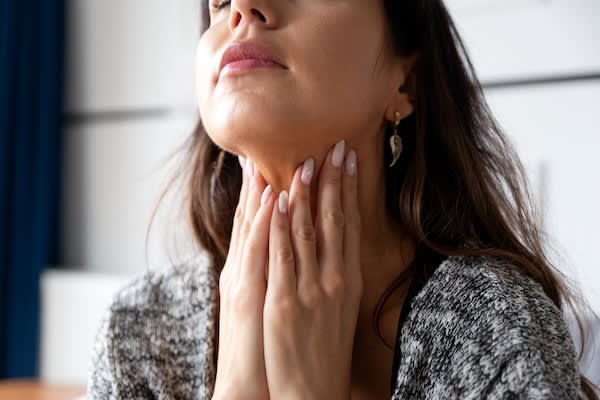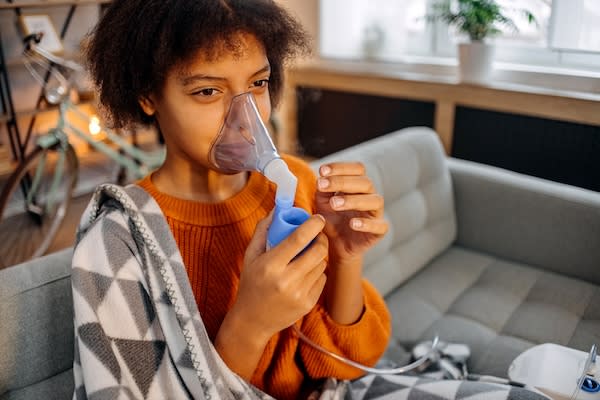Thyroid cancer is a rare but treatable disease

[5 MIN READ]
In this article:
-
Thyroid cancer is the No. 1 cancer for women for adolescents and young adults ages 15-39 and the second most common cancer for women in their 40s.
-
Fortunately, the majority of thyroid cancers are very treatable.
-
If you have a non-cancerous thyroid tumor, your doctor may be able to shrink it without surgery using radiofrequency or microwave ablation.
While you may not know much about your thyroid gland, it certainly knows a lot about you. Your thyroid produces thyroid hormones, which regulate your body temperature, metabolism, heart and neurocognitive functioning. When your body makes too much or too little of one or more thyroid hormones, it can affect your daily living and cause many other health problems.
Melanie Goldfarb, M.D., a fellowship-trained endocrine surgeon at Providence Specialty Medical Group in Santa Monica, California, recently talked about thyroid cancer, nodules and new treatments on an episode of the Talk With a Doc podcast.
All about thyroid cancer
Because thyroid cancer usually grows very slowly and rarely produces any symptoms, it can be difficult to detect early in the disease process.
“The cancer doesn’t affect the hormones, which is why you don’t get any symptoms,” says Dr. Goldfarb. “Most of the time, when you receive a thyroid cancer diagnosis, it’s because your doctor felt something, or you looked in the mirror and saw a growth. You can also detect thyroid cancer when you’re getting medical imaging for other issues, such as a carotid ultrasound or a lung computed tomography (CT) scan.”
Even when you or your doctor notice a growth, however, that doesn’t mean it’s cancerous. Tumors, also known as thyroid nodules, can be noncancerous. Depending on how big they are and if they’re causing any symptoms, you and your doctor could decide to just watch and wait. “Your doctor will order an ultrasound,” Dr. Goldfarb says, “and that will tell them whether it’s cancerous, benign or somewhere in the middle. That’s when you’ll either see an endocrinologist, endocrine surgeon or you’ll get sent for a biopsy.”
While the incidence of thyroid cancer is relatively rare, it’s actually most prevalent among people ages 15 to 40, and has overtaken breast cancer as the No. 1 cancer for women in their 20s and 30s. The only real risk factor for the disease is radiation therapy — if you have previously undergone radiation for another type of cancer in your neck area, you are more at risk for thyroid cancer than others might be.
Treatment for thyroid cancer
The good news is, thyroid cancer is very treatable. “One of the things I love about my specialty is that I really get to cure most people,” says Dr. Goldfarb. “Now, obviously, there are some people out there who have very aggressive cancers that are not as curable. But even people with super aggressive tumors, or a cancer that spreads (metastasizes), have better survivability than most other cancers out there.”
That said, you still do need to undergo treatment. “Thyroid cancer is really a surgical disease,” says Dr. Goldfarb. “There is no chemotherapy, radiation therapy or immunotherapy. We just have to get the cancer out of your body. Most of the time, that’s going to mean surgery, which includes removing either half of your thyroid or your entire thyroid, which is called a total thyroidectomy. If the cancer is in the lymph nodes, then we'll take out the lymph nodes in that area.”
The scope of the thyroid surgery depends on your cancer’s specific features — whether it’s small and contained, or if it has spread to the lymph nodes. “These days, if you have a really small cancer and you're a little older, we sometimes offer you active surveillance — kind of like what they do for prostate cancer. That means we don’t take it out, and we just watch you with serial imaging and ultrasounds to make sure it doesn’t grow. A newer option for very small, confined cancers is to ablate them using radiofrequency or microwave ablation in the office – without surgery.”
If your surgeon needs to remove your thyroid, you will start taking a thyroid hormone supplement after surgery so that your body functions can still be regulated.
Thermal (Radiofrequency and microwave) ablation
For situations in which the nodule is noncancerous but still needs to be removed, Dr. Goldfarb is one of the first doctors on the West Coast to offer radiofrequency ablation as a non-surgical treatment option.
“This procedure is not new or experimental,” she says. ”They’ve been doing it in Europe and Asia for 10-15 years, so there’s a lot of great long-term data. It just took a while to make it to the United States and to California.”
The ablation procedure burns away the tumor. “I explain it to patients in lay terms that I’m going to ‘cook’ their thyroid tumor with a tiny probe under 3D ultrasound guidance,” Dr. Goldfarb says. “When it’s dead, your body is going to reabsorb a lot of it. The procedure itself will take anywhere from 20 to 45 minutes, depending on how big your nodule is. You go right home and apply ice, but otherwise, you can do your thing. There’s no scar, there’s no hole, and slowly, over the course of about 12 months, the nodule is going to get smaller.”
While surgery is still the best step for thyroid cancer treatment, radiofrequency or microwave ablation is an excellent option for patients who want their benign tumor smaller, but don’t want to have to take thyroid hormone for the rest of their life.
Contributing caregiver

Melanie Goldfarb, M.D., is a fellowship-trained endocrine surgeon at Providence Specialty Medical Group in Santa Monica, California.
Find a doctor
If you are looking for a Providence endocrinologist or endocrine surgeon, you can search for one in our provider directory.
Download the Providence app
It’s all in the app: easily stay connected with Providence and your health. With the Providence app, you can schedule appointments, have virtual visits from the comfort of your own home, get health recommendations personalized for you, access your health records and so much more. Learn more and download the app.
Related resources
The ins and outs of Hashimoto’s disease
How to spot and treat thyroid disease
What women need to know about hormones and mental health
This information is not intended as a substitute for professional medical care. Always follow your health care professional’s instructions.



